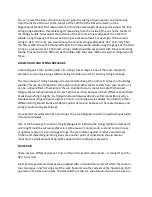
If the locking system incorporates a locking nut, remove the nut lock-down pieces while
installing the strings and going through the setup procedures. After the setup is complete,
replace the nut lock-down pieces, check your tuning and tighten the hex screws to lock the
strings at the nut. Caution: Do not over-tighten. Use the fine tuners at the bridge to
compensate for any tuning changes.
TREMOLO ADJUSTMENT
After the strings are installed, remove the tremolo back cover. Check your tuning. Allowing the
bridge to float freely (no tension on the tremolo arm) and using the claw screws in the tremolo
cavity, adjust the bridge to your desired angle (on most free-floating systems, it is
recommended that the bridge sit parallel to the body). You'll need to re-tune periodically to get
the right balance between the strings and the springs. For the flush-mounted bridges, you
might want to adjust the bridge to rest on the body. You can adjust the spring tension to an
equal string tension, with the bridge resting on body (you might want to put an extra 1/2 turn
to each claw screw to ensure that the bridge remains flush to the body during string bends).
Finally, you may wish to apply a small dab of lip balm or petroleum jelly at the pivot contact
points of the bridge for very smooth operation.
How do I set up my Stratocaster® guitar properly?
STRATOCASTER® ADJUSTMENT AND CARE
The following setup procedures and specifications are for your Stratocaster as equipped with
the strings that come on the instrument as standard equipment from the factory. If you plan to
change string gauges, you may need to adjust the specs somewhat to compensate for the
changes in string sizes. Modifications of the specs may also be made (within limited
parameters) to adjust for your individual playing style or application (i.e., how hard you pick,
strum or fret the guitar).
Note: These are minimum specifications that are meant as a guide; they should not be
construed as hard and fast rules, as we realize that every player's subjective requirements often
differ.
TOOLS NEEDED
Set of automotive feeler gauges (.002-.025) (0.05–1 mm)
6" (150 mm) ruler (with 1/32" and 1/64" increments) (0.5 mm increments)
Light machine oil (3-in-1, toy locomotive or gun oil)



























